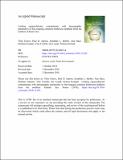Files in this item
Linking organochlorine contaminants with demographic parameters in free-ranging common bottlenose dolphins from the northern Adriatic Sea
Item metadata
| dc.contributor.author | Genov, Tilen | |
| dc.contributor.author | Jepson, Paul D. | |
| dc.contributor.author | Barber, Jonathan L. | |
| dc.contributor.author | Hace, Ana | |
| dc.contributor.author | Gaspari, Stefania | |
| dc.contributor.author | Centrih, Tina | |
| dc.contributor.author | Lesjak, Jan | |
| dc.contributor.author | Kotnjek, Polona | |
| dc.date.accessioned | 2019-12-04T00:37:34Z | |
| dc.date.available | 2019-12-04T00:37:34Z | |
| dc.date.issued | 2019-03-20 | |
| dc.identifier | 256853642 | |
| dc.identifier | 5d9846bb-fde0-41ce-988c-5a6c959a10f1 | |
| dc.identifier | 85057725840 | |
| dc.identifier | 000455903400021 | |
| dc.identifier.citation | Genov , T , Jepson , P D , Barber , J L , Hace , A , Gaspari , S , Centrih , T , Lesjak , J & Kotnjek , P 2019 , ' Linking organochlorine contaminants with demographic parameters in free-ranging common bottlenose dolphins from the northern Adriatic Sea ' , Science of the Total Environment , vol. 657 , pp. 200-212 . https://doi.org/10.1016/j.scitotenv.2018.12.025 | en |
| dc.identifier.issn | 0048-9697 | |
| dc.identifier.other | RIS: urn:8966430BE6D30F70E6D6AEA1F6778C20 | |
| dc.identifier.uri | https://hdl.handle.net/10023/19062 | |
| dc.description | This study was partially supported through the development of the expert baselines for the implementation of the EU Marine Strategy Framework Directive in relation to marine mammals in Slovenia, for which we are grateful to Monika Peterlin, Elizabeta Gabrijelčič and the Institute for Water of the Republic of Slovenia. OceanCare and Earthwatch Institute provided additional valuable support. | en |
| dc.description.abstract | Marine top predators, including marine mammals, are known to bio-accumulate persistent pollutants such as polychlorinated biphenyls (PCBs), a serious conservation concern for these species. Although PCBs declined in European seas since the 1970s–1980s ban, considerable levels still persist in European and Mediterranean waters. In cetaceans, stranded animals are a valuable source of samples for pollutant studies, but may introduce both known and unknown biases. Biopsy samples from live, free-ranging cetaceans offer a better alternative for evaluating toxicological burdens of populations, especially when linked to known histories of identified individuals. We evaluated PCB and other organochlorine contaminants in free-ranging common bottlenose dolphins (Tursiops truncatus) from the Gulf of Trieste (northern Adriatic Sea), one of the most human-impacted areas in the Mediterranean Sea. Biopsies were collected from 32 male and female dolphins during 2011–2017. All animals were photo-identified and are part of a well-known population of about 150 individuals monitored since 2002. We tested for the effects of sex, parity and social group membership on contaminant concentrations. Males had significantly higher organochlorine concentrations than females, suggesting offloading from reproducing females to their offspring via gestation and/or lactation. Furthermore, nulliparous females had substantially higher concentrations than parous ones, providing further support for maternal offloading of contaminants. Overall, 87.5% of dolphins had PCB concentrations above the toxicity threshold for physiological effects in experimental marine mammal studies (9 mg/kg lw), while 65.6% had concentrations above the highest threshold published for marine mammals based on reproductive impairment in ringed seals (41 mg/kg lw). The potential population-level effects of such high contaminant levels are of concern particularly in combination with other known or suspected threats to this population. We demonstrate the utility of combining contaminant data with demographic parameters such as sex, reproductive output, etc., resulting from long-term studies. | |
| dc.format.extent | 13 | |
| dc.format.extent | 1386455 | |
| dc.language.iso | eng | |
| dc.relation.ispartof | Science of the Total Environment | en |
| dc.subject | Organochlorine contaminants | en |
| dc.subject | PCBs | en |
| dc.subject | Ecotoxicology | en |
| dc.subject | Adriatic Sea | en |
| dc.subject | Mediterranean Sea | en |
| dc.subject | QH301 Biology | en |
| dc.subject | NDAS | en |
| dc.subject | SDG 14 - Life Below Water | en |
| dc.subject.lcc | QH301 | en |
| dc.title | Linking organochlorine contaminants with demographic parameters in free-ranging common bottlenose dolphins from the northern Adriatic Sea | en |
| dc.type | Journal article | en |
| dc.contributor.institution | University of St Andrews. School of Biology | en |
| dc.identifier.doi | https://doi.org/10.1016/j.scitotenv.2018.12.025 | |
| dc.description.status | Peer reviewed | en |
| dc.date.embargoedUntil | 2019-12-04 |
This item appears in the following Collection(s)
Items in the St Andrews Research Repository are protected by copyright, with all rights reserved, unless otherwise indicated.

